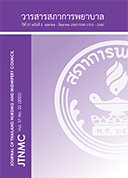Impact of Implementation of Clinical Nursing Practice Guidelines in Prevention of Venous Thromboembolism on Multiple Traumatic Injury Patients’ Incidence of Venous Thromboembolism, Length of Hospitalisation, and Medical Expenses
Keywords:
venous thromboembolism (VTE), clinical nursing practice guidelines in prevention of venous thromboembolism, length of hospitalisation, medical expenses, multiple traumatic injury patientsAbstract
Objective: To examine the implementation of clinical nursing practice guidelines in prevention of venous thromboembolism (VTE) and the impact of the guidelines on multiple traumatic injury patients’ incidence of venous thromboembolism, length of hospitalisation,
and medical expenses
Design: Two-group quasi-experimental study with a post-test
Methodology: This study was conducted on 40 subjects who were multiple traumatic injury patients admitted to a trauma ward. The subjects were equally assigned a control group and an experimental group. Whilst the control group was given standard nursing care, the experimental group received 14-day treatment based on the clinical nursing practice guidelines, which were comprised of three major components: 1) VTE risk assessment; 2) nursing care activities in prevention of VTE; and 3) VTE assessment using the Doppler ultrasonography. The instruments used in gathering data comprised: 1) a demographic data form; 2) a VTE risk assessment form; 3) a VTE incidence report; 4) a length of hospitalisation report; and 5) a medical expense record. The data were analysed using descriptive statistics, chi-square test, independent t- test, and Mann-Whitney U-test.
Results: Incidence of VTE was not found in the experimental group but found in 25% of the members of the control group, which constituted is statistically signifcant difference (p < .05). In addition, the experimental group’s length of hospitalisation and medical expenses were signifcantly lower than the control group’s (p < .05).
Recommendations: Nurses are recommended to apply this set of guidelines to caring for multiple traumatic injury patients right from the start of hospitalisation, to reduce incidence of venous thromboembolism, length of hospitalisation, and medical expenses.
Downloads
References
Hillegass E, Puthoff M, Frese EM, Thigpen M, Sobush DC, Auten B. Role of physical therapists in the management of individuals at risk for or diagnosed with venous thromboembolism: evidence-Based clinical practice guideline. Phys Ther 2016; 96(2): 143-66. doi: 10.2522/ptj.20150264.
Nielsen S, O’Connor D, Kaul S, Sharma J, Napolitano M, Simonian G, et al. Early detection of veep venous thrombosis in trauma patients. Cureus 2020;12(7): 1–9. https://dx.doi.org/10.7759/cureu.
Strandvik G, El-Menyar A, Asim M, Galwankar S, Al-Thani H. Clinical characteristics, management practices, and in-hospital outcomes among trauma patients with venous thromboembolism. J Emerg Trauma Shock 2020;13(2):124–30. doi:10.4103/ JETS.JETS_83_19.
Norasan S, Gajasen C, Soonthonkit Y, Jaihow R, Sripoom T, Singhatas P. Assessing the risk and incident of deep vein thrombosis in ICU trauma patients, Ramathibodi Hospital using Caprini Score. Journal of Nursing Division 2020;47(2):20-31. (in Thai).
Abas Osman A, Ju W, Sun D, Qi B. Deep venous thrombosis: a literature review. Int J Clin Exp Med 2018;11(3):1551-6. [cited 2021 june 1]. Available from: URL: http://www.ijcem.com/fles/ijcem0060561.pdf.
Chuenjit K, Ua-kit N. The effect of leg exercise combined with reflexology on femoral venous blood flow velocity in post abdominal surgery patients. Kuakarun Journal of Nursing 2017; 24(1):163- 77. (in Thai).
Grabo DJ, Seery JM, Bradley M, Zakaluzny S, Kearns MJ, Fernandez N, et al. Prevention of deep venous thromboembolism. Mil Med 2018;183(1): 133–6. doi: 10.1093/milmed/usy072.
Modi S, Deisler R, Gozel K, Reicks P, Irwin E, Brunsvold M, et al. Wells criteria for DVT is a reliable clinical tool to assess the risk of deep venous thrombosis in trauma patients. World J Emerg Surg 2016;11(1): 1-6. doi: 10.1186/s13017-016-0078-1.
Strandvik G, El-Menyar A, Asim M, Galwankar S, Al-Thani H.Clinical characteristics, management practices, and in-hospital outcomes among trauma patients with venous thromboembolism. J Emerg Trauma Shock 2020;13(2):124–30. doi: 10.4103/JETS.JETS_83_19
Pattanakuhar S, Kammuang-lue P, Tongprasert S, Kovindha A,Tantiworawit A. Prevention for venous thromboembolism in spinal cord injury patients. Journal of Thai Rehabilitation Medicine 2018;28(1): 24-31. (in Thai).
Wallis M, Autar R. Deep vein thrombosis: clinical nursing management. Nurs Stand 2001;15(18):47-54. doi: 107748/ns2001.01.15.18.47.c2969.
Sriprayoon W, Surakan E, Siriwanitchaphan W. Prevalence of venous thromboembolism in trauma patients in a trivate tertiary care hospital. The Bangkok Medical Journal 2020;16(1);13-5. (in Thai).
Cardoso LF, Krokoscz DVC, de Paiva EF, Furtado IS, Mattar J, de Souza e Sá MM, et al. Results of a venous thromboembolism prophylaxis program for hospitalized patients. Vasc Health Risk Manag 2016;12(1):491–6. doi:10.2147/VHRM. S101880.
Nanclares BVC, Padilla-Zambrano HS, El-Menyar A, Moscote-Salazar LR, Galwankar S, Pal R, et al. WACEM consensus paper on deep venous thrombosis after traumatic spinal cord injury. J Emerg Trauma Shock 201912(2): 150–4. doi: 10.4103/JETS. JETS_125_18.
Promlek K, The development and evaluation of clinical nursing practice guideline for prevention deep veine trombosis in critical III trauma patient. [Dissertation]. Songkhla: Prince of Songkla University; 2010. (in Thai)
Songwathana P, Promlek K, Naka K. Evaluation of a clinical nursing practice guideline for preventing deep vein thrombosis in critically ill trauma patients. Australas Emerg Nurs J 2011;14(4):232–9. doi: 10.1016/j.aenj.2011.09.002.
Fisher WD, Agnelli G, George DJ, Kakkar AK, Lassen MR, Mismetti P, et al. Extended venous thromboembolism prophylaxis in patients undergoing hip fracture surgery-The SAVE-HIP3 study. Bone Jt J. 2013; 95(4): 459–66. doi: 10.1302/0301- 620X. 95B4.30730.
Lau BD, Murphy P, Nastasi AJ, Seal S, Kraus PS, Hobson DB, et al. Effectiveness of ambulation to prevent venous thromboembolism in patients admitted to hospital: a systematic review. CMAJ Open 2020; 8(4),E832-43. https://dx.doi.org/10.9778/cmajo.
Heyes GJ, Tucker A, Michael ALR, Wallace RGH. The incidence of deep vein thrombosis and pulmonary embolism following cast immobilisation and early functional bracing of Tendo Achilles rupture without thromboprophylaxis.Eur J Trauma Emerg Surg 2015; 41(3):273–6. doi: 10.1007/s00068-014-0408-5.
Duff J, Walker K, Omari A, Stratton C. Prevention of venous thromboembolism in hospitalized patients: analysis of reduced cost and improved clinical outcomes. J Vasc Nurs 2013; 31(1):9–14. doi: 10.1016/j. jvn.2012.06.006.
Millar JA, Gee ALK. Estimation of clinical and economic effects of prophylaxis against venous thromboembolism in medical patients, including the effect of targeting patients at high-risk. Intern Med J 2016;46(3):315–24. doi: 10.1111/imj.12995.
Downloads
Published
How to Cite
Issue
Section
License
Copyright (c) 2022 Thai Journal of Nursing Council

This work is licensed under a Creative Commons Attribution-NonCommercial-NoDerivatives 4.0 International License.








